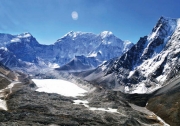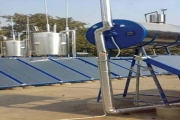Climate and Weather
Mining - An increasing threat to our rivers - Article by Nitya Jacob
Posted on 20 Dec, 2010 12:29 AMContent Courtesy: Solution Exchange and Nitya Jacob
Author: Nitya Jacob
India’s arteries are choking. Her rivers, the lifeline of hundreds of millions, are over-taxed, polluted and encroached. They are being mined, dammed and emptied of water. Save for the four monsoon months, most rivers are streams of drains, depending on how many cities they pass through. This year people gaped in awe at the River Yamuna (I am sure they were over-awed by other rivers elsewhere too) as for the first time since 1978 looked like a river and not a drain.
Water poverty in the northeastern hill region of India: Potential alleviation through multiple-use water systems - A report by IWMI
Posted on 20 Dec, 2010 12:07 AM This study by IWMI maps the household water poverty in a typical remote village of the northeast, understands the causes for such a scenario and reflects on the past efforts. Local water resource-based multiple-use water systems that provide water supply both for household and livestock needs and for small high-value agriculture are understood.
This study by IWMI maps the household water poverty in a typical remote village of the northeast, understands the causes for such a scenario and reflects on the past efforts. Local water resource-based multiple-use water systems that provide water supply both for household and livestock needs and for small high-value agriculture are understood.
The per capita and per hectare availability of water in India is highest in this region but the societal (both productive and consumptive) water use is less than five per cent of the existing potential. The unutilised and excessive water supplies during the rainy season create a mayhem of devastations almost every year with ravaging floods, landslides, soil erosion and other infrastructural failures and miseries and unrest in large parts.
Formation of glacial lakes in the Hindu Kush-Himalayas and Glacial Lake Outburst Flood risk assessment - A report by ICIMOD
Posted on 19 Dec, 2010 05:17 PM This report by ICIMOD contains an assessment of the threat facing the Hindu Kush-Himalayan region from the recent (post-1950s) and rapid formation of meltwater lakes on the surface or at the end of a large number of the region’s glaciers owing to current climate warming. Individual case studies of the catastrophic outburst (glacial lake outburst floods or GLOFs) from such glacial lakes are introduced.
This report by ICIMOD contains an assessment of the threat facing the Hindu Kush-Himalayan region from the recent (post-1950s) and rapid formation of meltwater lakes on the surface or at the end of a large number of the region’s glaciers owing to current climate warming. Individual case studies of the catastrophic outburst (glacial lake outburst floods or GLOFs) from such glacial lakes are introduced.
Himalayi Jan Goshnapatra: Himalayi Niti Ka Prarup – A report in Hindi by the Gandhi Peace Foundation
Posted on 18 Dec, 2010 08:19 AMThis document in Hindi prepared by the Gandhi Peace Foundation, is a blueprint of the Himalayan People's Manifesto. The manifesto has been brought out with the help of various documents prepared by various people and organisations at different times. It will be finalised by the next Himalayan Day on September 9, 2011.
Conceptual framework of South Asian water futures exchange - Commodity Vision
Posted on 18 Dec, 2010 12:15 AMIn this article published in Commodity Vision, the author presents the concept of the establishment of a 'futures market in water availability' in the context of the risk of water availability that Indian agriculture has been facing in the recent years.
With South Asian agriculture being dependent on the timely occurrence of the monsoons, any deviation from the scheduled arrival of the monsoon causes problems not only for the farmers, but also produces a threat to the food security of the region. However, the author argues that, there is no market in South Asia where users and investors exposed to water availability risk can effectively hedge against such a risk.
Mine the gap: Connecting water risks and disclosure in the mining sector – A report by the World Resources Institute
Posted on 17 Dec, 2010 10:43 PMThis paper by the World Resources Institute outlines potential water-related risks facing the mining industry and highlights important gaps in water-related disclosure. The purpose is to provide information, questions, and tools to help the financial community better evaluate water-related risks facing mining companies.
Water management across space and time in India – A working paper by the University of Bonn
Posted on 17 Dec, 2010 10:09 PMThis working paper by the University of Bonn attempts to give a spatial and temporal overview of water management in India. It traces how people and the successive regimes made choices across space and time from a wide range of water control and distribution technologies. The paper divides the water management in India into four periods –
- the traditional system of water management before colonial times;
- response from the colonial rulers to manage the complex socio-ecological system;
- large scale surface water development after independence; and
- finally, the small-scale community and market-led revolution.
Users handbook on Solar Water Heaters by the Ministry of New and Renewable Energy
Posted on 17 Dec, 2010 07:56 PM This user’s handbook on Solar Water Heaters by the Ministry of New and Renewable Energy (MNRE) in collaboration with the UNDP/UNEP/GEF Global Solar Water Heating Market Transformation Strengthening Initiative attempts to transform the solar water heating market in India.
This user’s handbook on Solar Water Heaters by the Ministry of New and Renewable Energy (MNRE) in collaboration with the UNDP/UNEP/GEF Global Solar Water Heating Market Transformation Strengthening Initiative attempts to transform the solar water heating market in India.
Water footprint assessments of dehydrated onion products of Jain Irrigation Systems Ltd – A report by IFC
Posted on 17 Dec, 2010 07:05 PMThis work on water footprint assessments represents a pioneering effort on documenting the water consumption in Jain Irrigation Systems Limited’s (JISL) production of dehydrated onions and of micro-irrigation systems. It also assesses the sustainability of this water consumption and formulate response strategies.
Heavy rainfall, floods and drought affect life, agriculture and economy of the country - News Roundup (8-15 December 2010)
Posted on 17 Dec, 2010 12:22 AMReports over the last week indicate heavy rains and loss of lives and property in the state of Tamil Nadu, which has faced the maximum brunt of the rains followed by Kerala, Andhra Pradesh and some parts of Sikkim and Himachal Pradesh. Reports also indicate that there have been massive losses to agricultural produce due to heavy rains in parts of Tamil Nadu, Andhra Pradesh and because of droughts in the state of Orissa. At the same time, reports also indicate good news that there has been a rise in the water levels in the country and of attempts being made in different parts of the country to cope with floods and excessive rains in the future.
Rainfall
Tamil Nadu
- Tamil Nadu: The north-east monsoon, 50 per cent in excess in the State, claims over 200 lives and destroys crops and infrastructure
- After the deluge: Chennai has received 71 cm of rain during this year's northeast monsoon, leaving the roads in the Chennai Metropolitan Area in shambles
- The rain-hit north and south Chennai, Tamil Nadu get some respite even as several areas, including Velachery and Taramani, remained under a sheet of water, affecting hundreds of people
- Rain stops, but no end to woes for people from Chennai, Tamil Nadu
- Rain pours non-stop misery in Tamil Nadu
- 2,000 people rescued from low-lying areas along river Tamirabarani, in Kanyakumari district
- Torrential rain kills over 200 in Tamil Nadu
- 70 % excess rainfall in Cuddalore district, Tamil Nadu





